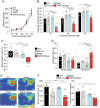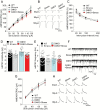Stress Exposure in Dopamine D4 Receptor Knockout Mice Induces Schizophrenia-Like Behaviors via Disruption of GABAergic Transmission
- PMID: 30476265
- PMCID: PMC6737476
- DOI: 10.1093/schbul/sby163
Stress Exposure in Dopamine D4 Receptor Knockout Mice Induces Schizophrenia-Like Behaviors via Disruption of GABAergic Transmission
Abstract
A combination of genetic and environmental risk factors has been considered as the pathogenic cause for mental disorders including schizophrenia. Here, we sought to find out whether the abnormality of the dopamine system, coupled with the exposure to modest stress, is sufficient to trigger the manifestation of schizophrenia-like behaviors. We found that exposing dopamine D4 receptor knockout (D4KO) mice with 1-week restraint stress (2 h/d) induced significant deficits in sensorimotor gating, cognitive processes, social engagement, as well as the elevated exploratory behaviors, which are reminiscent to schizophrenia phenotypes. Electrophysiological studies found that GABAergic transmission was significantly reduced in prefrontal cortical neurons from stressed D4KO mice. Additionally, administration of diazepam, a GABA enhancer, restored GABAergic synaptic responses and ameliorated some behavioral abnormalities in stressed D4KO mice. These results have revealed that the combination of 2 key genetic and environmental susceptibility factors, dopamine dysfunction and stress, is a crucial trigger for schizophrenia-like phenotypes, and GABA system in the prefrontal cortex is a downstream convergent target that mediates some behavioral outcomes.
Keywords: GABA; dopamine D4 receptor; schizophrenia; stress.
© The Author(s) 2018. Published by Oxford University Press on behalf of the Maryland Psychiatric Research Center. All rights reserved. For permissions, please email: journals.permissions@oup.com.
Figures






Similar articles
-
Genetic Disruption of Arc/Arg3.1 in Mice Causes Alterations in Dopamine and Neurobehavioral Phenotypes Related to Schizophrenia.Cell Rep. 2016 Aug 23;16(8):2116-2128. doi: 10.1016/j.celrep.2016.07.044. Epub 2016 Aug 11. Cell Rep. 2016. PMID: 27524619 Free PMC article.
-
D2 and D4 dopamine receptor mRNA distribution in pyramidal neurons and GABAergic subpopulations in monkey prefrontal cortex: implications for schizophrenia treatment.Neuroscience. 2010 Nov 10;170(4):1133-9. doi: 10.1016/j.neuroscience.2010.08.025. Epub 2010 Aug 19. Neuroscience. 2010. PMID: 20727949
-
Dopamine D4 receptors modulate GABAergic signaling in pyramidal neurons of prefrontal cortex.J Neurosci. 2002 Nov 1;22(21):9185-93. doi: 10.1523/JNEUROSCI.22-21-09185.2002. J Neurosci. 2002. PMID: 12417643 Free PMC article.
-
Prefrontal cortical gamma-aminobutyric acid transmission and cognitive function: drawing links to schizophrenia from preclinical research.Biol Psychiatry. 2015 Jun 1;77(11):929-39. doi: 10.1016/j.biopsych.2014.09.007. Epub 2014 Nov 18. Biol Psychiatry. 2015. PMID: 25442792 Review.
-
Altered GABA neurotransmission and prefrontal cortical dysfunction in schizophrenia.Biol Psychiatry. 1999 Sep 1;46(5):616-26. doi: 10.1016/s0006-3223(99)00061-x. Biol Psychiatry. 1999. PMID: 10472415 Review.
Cited by
-
Effects of Environmental Noise Stress on Mouse Metabolism.Int J Mol Sci. 2024 Oct 12;25(20):10985. doi: 10.3390/ijms252010985. Int J Mol Sci. 2024. PMID: 39456767 Free PMC article.
-
Peripheral biomarkers of treatment-resistant schizophrenia: Genetic, inflammation and stress perspectives.Front Pharmacol. 2022 Oct 12;13:1005702. doi: 10.3389/fphar.2022.1005702. eCollection 2022. Front Pharmacol. 2022. PMID: 36313375 Free PMC article. Review.
-
Cognitive impairment in psychiatric diseases: Biomarkers of diagnosis, treatment, and prevention.Front Cell Neurosci. 2022 Nov 2;16:1046692. doi: 10.3389/fncel.2022.1046692. eCollection 2022. Front Cell Neurosci. 2022. PMID: 36406755 Free PMC article. Review.
-
Autism risk gene KMT5B deficiency in prefrontal cortex induces synaptic dysfunction and social deficits via alterations of DNA repair and gene transcription.Neuropsychopharmacology. 2021 Aug;46(9):1617-1626. doi: 10.1038/s41386-021-01029-y. Epub 2021 May 18. Neuropsychopharmacology. 2021. PMID: 34007043 Free PMC article.
-
Systemic histone deacetylase inhibition ameliorates the aberrant responses to acute stress in socially isolated male mice.J Physiol. 2024 May;602(9):2047-2060. doi: 10.1113/JP285875. Epub 2024 Mar 18. J Physiol. 2024. PMID: 38500302 Free PMC article.
References
-
- Flaum M, Andreasen NC. Diagnostic criteria for schizophrenia and related disorders: options for DSM-IV. Schizophr Bull. 1991;17:133–156. - PubMed
-
- Hilker R, Helenius D, Fagerlund B, et al. . Heritability of schizophrenia and schizophrenia spectrum based on the nationwide Danish twin register. Biol Psychiatry. 2018;83:492–498. - PubMed
-
- Abdolmaleky HM, Thiagalingam S, Wilcox M. Genetics and epigenetics in major psychiatric disorders: dilemmas, achievements, applications, and future scope. Am J Pharmacogenomics. 2005;5:149–160. - PubMed
-
- Khan ZU, Gutiérrez A, Martín R, Peñafiel A, Rivera A, De La Calle A. Differential regional and cellular distribution of dopamine D2-like receptors: an immunocytochemical study of subtype-specific antibodies in rat and human brain. J Comp Neurol. 1998;402:353–371. - PubMed
Publication types
MeSH terms
Substances
Grants and funding
LinkOut - more resources
Full Text Sources
Medical

